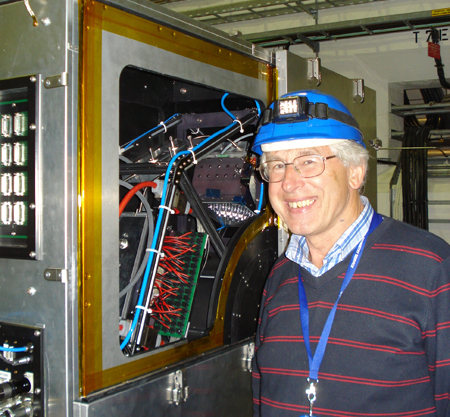Dr John Fry with the KTAG detector
UNIVERSITY of Liverpool scientists are engaged in an experiment searching for extremely rare decays of a kaon. Only 3 candidates for this rare decay have been seen worldwide, whereas the Liverpool scientists are hoping to identify several hundred.
Using equipment designed by Dr John Fry and Peter Sutcliffe and constructed by University technicians within the Department of Physics, the team plans to identify the charged kaons prior to their decay into a pion and two neutrinos. The equipment forms part of the NA62 experiment at CERN and will take place 100 metres underground, inside the 270m long high-intensity experimental hall.
Dr Fry has overseen the design and installation of the £2M KTAG detector funded by the European Research Council; he said: “Our detector will receive a beam of about 800 million particles per second [800 MHz]. About 6% of those particles are kaons, and about one in every 10,000 million is potentially a kaon that is going to decay into a pion and two neutrinos.
“We’re going to ‘tag’ each individual kaon, measure the time it enters our detector very precisely, and track its decay all the way through the experiment. The hard part is that all the other kaon decays have to be rejected without losing the very precious, rare decays.”
The quality of the KTAG detector is a testament to the highly skilled technicians that have been involved in its construction. For example, making the 8 arrays of tiny cones that channel Cerenkov light from kaons travelling faster than light in the gas at the heart of the detector to the photomultiplier tubes where it is recorded was a labour of love.
University of Liverpool senior technician, Kevin McCormick had to get to grips with ellipsoidal geometry to ensure that each of the 8 sets of 64 cones would sit on a spherical shell around the beam. He then machined each cone before they were lined with highly reflective aluminised-mylar. The resulting array is both visually and scientifically stunning.
NA62 is being carried out in collaboration with the Universities of Bristol and Birmingham and scientists from universities in Europe and the United States. In a Technical Run at CERN during November the Liverpool team were able to identify charged kaons in the 800 MHz beam with high efficiency and to measure the time of an individual kaon to better than 100 ps.
Dr Fry expressed his delight at the performance of KTAG and said: “Having shown that our detector exceeds the design specification, the Liverpool scientists will now concentrate on preparing to analyse physics data from running the experiment over the next 3 years.”
